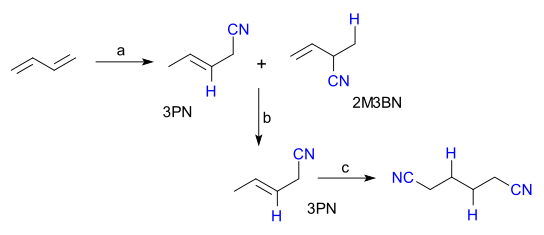Adiponitrile
 | |
 | |
| Names | |
|---|---|
| IUPAC name
Hexanedinitrile[1] | |
Other names
| |
| Identifiers | |
| 3D model (JSmol) |
|
| 1740005 | |
| ChemSpider | |
| ECHA InfoCard | 100.003.543 |
| EC Number | 203-896-3 |
| MeSH | adiponitrile |
| PubChem CID |
|
| RTECS number | AV2625000 |
| UNII | |
| UN number | 2205 |
| |
| |
| Properties | |
| C6H8N2 | |
| Molar mass | 108.14 g·mol−1 |
| Appearance | Colourless liquid |
| Density | 951 mg mL−1 |
| Melting point | 1 to 3 °C; 34 to 37 °F; 274 to 276 K |
| Boiling point | 295.1 °C; 563.1 °F; 568.2 K |
| 50 g/L (20 °C) | |
| Vapor pressure | 300 mPa (at 20 °C) |
| Refractive index (nD) |
1.438 |
| Thermochemistry | |
| Std enthalpy of formation (ΔfH |
84.5–85.3 kJ mol−1 |
| Hazards | |
| GHS pictograms |  |
| GHS signal word | DANGER |
| H301, H315, H319, H330, H335 | |
| P260, P284, P301+310, P305+351+338, P310 | |
| NFPA 704 | |
| Flash point | 93 °C; 199 °F; 366 K (open cup)[2] |
| 550 °C (1,022 °F; 823 K) | |
| Explosive limits | 1.7–4.99% |
| Lethal dose or concentration (LD, LC): | |
| LD50 (median dose) |
155 mg kg−1 (oral, rat) |
| US health exposure limits (NIOSH): | |
| PEL (Permissible) |
none[2] |
| REL (Recommended) |
TWA 4 ppm (18 mg/m3)[2] |
| IDLH (Immediate danger) |
N.D.[2] |
| Related compounds | |
| Related alkanenitriles |
Glutaronitrile |
| Related compounds |
hexanedioic acid hexanedihydrazide hexanedioyl dichloride hexanediamide |
| Except where otherwise noted, data are given for materials in their standard state (at 25 °C [77 °F], 100 kPa). | |
| | |
| Infobox references | |
Adiponitrile is the organic compound with the formula (CH2)4(CN)2. This dinitrile, a viscous, colourless liquid, is an important precursor to the polymer nylon-6,6. In 2005, about one billion kilograms were produced annually.[3]
Production
Early routes
Because of the industrial value of adiponitrile, many methods have been developed for its synthesis. Early industrial routes started from furfural and later by the chlorination of butadiene to give 1,4-dichloro-2-butene, which with sodium cyanide, converts to 3-hexenedinitrile, which in turn can be hydrogenated to adiponitrile:[3]
- ClCH2CH=CHCH2Cl + 2 NaCN → NCCH2CH=CHCH2CN + 2 NaCl
- NCCH2CH=CHCH2CN + H2 → NC(CH2)4CN
Adiponitrile has also been produced from adipic acid, by dehydration of the diamide, but this route is rarely employed.
Modern routes
The majority of adiponitrile is prepared by the nickel-catalysed hydrocyanation of butadiene, as discovered at DuPont, pioneered by Drinkard. The net reaction is:
- CH2=CHCH=CH2 + 2 HCN → NCCH2CH2CH2CH2CN

The process involves several stages, the first of which involves monohydrocyanation (addition of one molecule of HCN), affording isomers of pentenenitriles as well as 2- and 3-methylbutenenitriles. These unsaturated nitriles are subsequently isomerized to the 3-and 4-pentenenitriles. In the final stage, these pentenenitriles are subjected to a second hydrocyanation, in an anti-Markovnikov sense, to produce adiponitrile.[3]
Research has shown that the 3-pentenenitrile, formed in the first hydrocyanation, can undergo alkene metathesis to give dicyanobutenes, which are readily hydrogenated as described above.
The other major industrial route involves electrosynthesis, starting from acrylonitrile, which is dimerized:
- 2 CH2=CHCN + 2 e− + 2 H+ → NCCH2CH2CH2CH2CN
The electrolytic coupling of acrylonitrile was discovered at Monsanto Company.
Applications
Almost all adiponitrile is hydrogenated to 1,6-diaminohexane for the production of nylon:[4]
- NC(CH2)4CN + 4 H2 → H2N(CH2)6NH2
Like other nitriles, adiponitrile is susceptible to hydrolysis. The resulting adipic acid however is more cheaply prepared by other routes.
Safety
The LD50 for adiponitrile is 300 mg/kg for oral ingestion by rats.[3]
In 1990, ACGIH adopted a time weighted average Threshold Limit Value of 2ppm for work related skin exposure.[5]
The NIOSH recommended skin exposure limit for a work related time weighted average concentration is 4ppm (18mg/m3).[6]
It is classified as an extremely hazardous substance in the United States as defined in Section 302 of the U.S. Emergency Planning and Community Right-to-Know Act (42 U.S.C. 11002), and is subject to strict reporting requirements by facilities which produce, store, or use it in significant quantities.[7]
References
- ↑ "adiponitrile - Compound Summary". PubChem Compound. USA: National Center for Biotechnology Information. 26 March 2005. Identification. Retrieved 15 June 2012.
- 1 2 3 4 "NIOSH Pocket Guide to Chemical Hazards #0015". National Institute for Occupational Safety and Health (NIOSH).
- 1 2 3 4 M. T. Musser, "Adipic Acid" in Ullmann's Encyclopedia of Industrial Chemistry, Wiley-VCH, Weinheim, 2005. doi:10.1002/14356007.a01 269
- ↑ Robert A. Smiley "Hexamethylenediamine" in Ullmann's Encyclopedia of Industrial Chemistry, Wiley-VCH, Weinheim, 2005. doi:10.1002/14356007.a12 629
- ↑ 2009 TLVs and BEIs, American Conference of Governmental Industrial Hygienists, Signature Publications, page 11 of 254.
- ↑ NIOSH Pocket Guide NIOSH Publication 2005-149; September 2005
- ↑ "40 C.F.R.: Appendix A to Part 355—The List of Extremely Hazardous Substances and Their Threshold Planning Quantities" (PDF) (July 1, 2008 ed.). Government Printing Office. Retrieved October 29, 2011.
External links
- International Chemical Safety Card 0211
- "NIOSH Pocket Guide to Chemical Hazards #0015". National Institute for Occupational Safety and Health (NIOSH).
- www.chemicalland.com
- www.nist.gov
